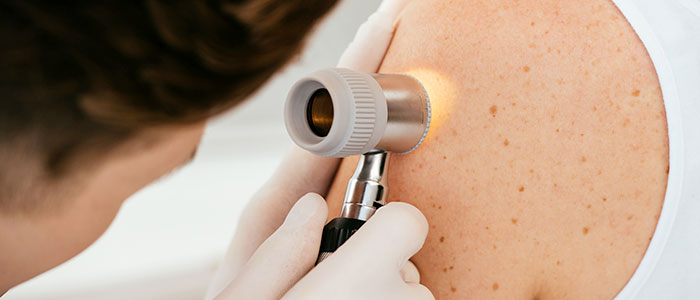
Summer is right around the corner, which, for many, means an end to cold days and cabin fever and the start of outdoor activities in the warm sunshine.
It also means your skin may be exposed to the sun, increasing the risk of sunburns and skin damage from dangerous ultraviolet (UV) rays. Skin cancer is the most common form of cancer in the United States, with one in five Americans developing the disease during their lifetime.
Additionally, recent studies show that cases of melanoma, the most dangerous form of skin cancer, has been increasing in both men and women.
Since UV rays, which come from the sun, are linked to skin cancer, you may think that living in one of the southern regions of the U.S., such as Hawaii, would increase your risk for the disease, and you’d be partially correct. But most of the states with the highest skin cancer rates might surprise you.
In this article, we’ll explore:
- Does where you live affect your risk for skin cancer?
- Study investigated melanoma rates by state
- Skin cancer facts and figures
- Does UV light cause skin cancer?
- Additional skin cancer risks
- Reducing you skin cancer risk
If you’ve been diagnosed with melanoma and are interested in a second opinion about your diagnosis or treatment options, call us or chat online with a member of our team.
Does where you live affect your risk for skin cancer?
In a study published in the International Journal of Cancer researchers analyzed melanoma cancer rates by state. They compared the incidence and number of cases linked to UV radiation and found that northern states – including Utah, Delaware, Vermont, New Hampshire and Minnesota – ranked among the highest risk.
The high rate of melanoma in northern states was likely the result of a combination of factors, including:
- Ethnicity of the population
- Strength of the sun’s rays (UV index)
- Participation in outdoor activities
- Use of sun protection
- Use of indoor tanning salons
- Lack of early detection
For example, Utah and Vermont have high populations of fair-skinned people, and their most popular outdoor recreation activities are walking and hiking. Without proper sun protection, residents of these states are at a higher risk for melanoma as well as more common types of skin cancer, such as basal cell carcinoma and squamous cell carcinoma.
Study investigated melanoma rates by state
For the study, investigators estimated the number, proportion and incidence rates of melanomas caused by UV radiation in each state and the District of Columbia.
At the state level they focused their analysis on non-Hispanic whites since this ethnic group is most likely to develop melanoma (27.2 per 100,000). Incidence rates are substantially lower in other ethnic groups (for example, 4.5 per 100,000 in Hispanic Americans and 1 per 100,000 in African Americans).
Here are some key take-aways from the study:
- Hawaii had the highest proportion of melanoma due to UV radiation—97 percent of all melanoma cases. Utah had the second highest proportion of UV-attributed melanoma with 95 percent of all cases.
- Alaska and the District of Columbia had the lowest proportion of UV-related melanoma cases.
- Among states with the highest rates are several landlocked states: Vermont, Utah, Minnesota, Idaho, Kentucky, and Colorado.
- Men are more likely than women to develop melanoma, except those under age 45, in which case a women’s risk is higher. This may be due to the use of tanning beds by younger women.
- About 33 percent of men and 25 percent of women said they do not use any sun protection and only 22 percent of men and 40 percent of women use sunscreen with a sun protection factor (SPF) of 15 or more.
- At the current rate, melanoma is expected to increase from 5.5 percent of all cancers diagnosed per year (about 97,000 cases) to 7.1 percent (151,000 cases) per year by 2030.
The most sobering statistic is that melanoma is responsible for about 75 percent of all skin cancer deaths.
“Despite these variations (by state), the relatively high burden of UV-attributable melanoma in each state highlights the need for prevention strategies that reach the entire U.S. population,” the study’s authors wrote.

Skin cancer facts and figures
According to the American Academy of Dermatology Association and the National Cancer Institute:
One in five Americans will develop skin cancer in their lifetime.
About 9,500 Americans are diagnosed daily with some form of with skin cancer.
Skin cancer among non-Hispanic white Americans is almost 30 times higher than among non-Hispanic Black or Asian/Pacific Islanders.
Basal cell and squamous cell carcinomas, the two most common types of skin cancer, are highly treatable if detected early and treated properly.
Melanoma of the skin is the fifth most common cancer diagnosed in the U.S., with about 97,000 new cases diagnosed each year.
More than 1 million Americans are living with melanoma.
The five-year survival rates for patients diagnosed with melanoma are:
- 99 when the cancer is localized
- 74 percent when the cancer has spread nearby
- 36 percent when the cancer has metastasized
Nearly 20 Americans die from melanoma every day. Nearly 8,000 Americans are expected to die of melanoma in 2023.
Melanoma death rates declined between by about 4 percent between 2014 and 2019, thanks largely to advances in immunotherapy.
Does UV light cause skin cancer?
UV radiation damages the DNA in skin cells, which may lead to mutations that cause skin cancer. There are three main types of UV (ultraviolet) radiation: UVA, UVB, and UVC. These types of radiation are differentiated by their wavelengths and their effects on our skin:
- UVA radiation has the longest wavelength and penetrates the skin deeply, reaching the dermis layer. It causes skin aging, wrinkles and some types of skin cancer, including melanoma.
- UVB radiation has a shorter wavelength than UVA and mostly affects the outer layer of the skin. It’s responsible for sunburn and is a major cause of most skin cancers, including basal cell carcinoma and squamous cell carcinoma.
- UVC radiation has the shortest wavelength and is the most harmful. However, it’s filtered out by the Earth's atmosphere. The only way people can be exposed to UVC radiation is from an artificial source like a lamp or laser. UVC lamps can burn your skin and irritate your eyes, but the risk of permanent damage or skin cancer is thought to be low.

Additional skin cancer risks
Most skin cancers result from overexposure to sunlight and tanning beds, with the risk growing with the amount of exposure. Besides UV light exposure, common skin cancer risks include:
- Fair skin: People with light-colored skin, hair and eyes are more susceptible to skin damage and skin cancer from UV radiation.
- Moles: Most moles will never cause any problems, people who have many moles may be more likely to develop melanoma.
- Inherited conditions: Conditions such as xeroderma pigmentosum, an inherited disease that affects the skin’s ability to repair UV damage, are at increased risk for developing melanoma, and may develop it at an earlier age.
- Exposure to certain chemicals such as arsenic, industrial tar, coal, paraffin and certain types of oil are more likely to develop skin cancers.
- Multiple sunburns: People, especially children, who have had five or more blistering sunburns in their lifetime have an increased risk of melanoma.
- Age: Nearly half of all new melanoma cases are diagnosed in patients between the ages of 55 and 74. But melanoma may affect people of all ages. It’s among the most common types of cancer in women ages 25 to 29.
- Weakened immune system: People undergoing chemotherapy, those with HIV/AIDS and organ transplant recipients are among those at a higher risk for skin cancer.
- Previous skin cancer: If you've had skin cancer in the past, you're at a higher risk of developing it again.
Reducing your skin cancer risk
The most important ways to help prevent skin cancer are by avoiding risk factors and increasing protective factors, according to the National Cancer Institute (NCI). Some strategies include:
- Avoid sun tanning and tanning beds. A suntan is an indication of damage to your skin and does not protect against burning.
- Seek shade during the heat of the day when possible. Keep in mind that the sun's UV rays are strongest between 10 a.m. and 4 p.m.
- Wear protective clothing, including a long-sleeved shirt, pants, a wide-brimmed hat and UV-protected sunglasses.
- Protect all exposed skin by using a sunscreen with a sun protection factor (SPF) of 30 that provides broad-spectrum protection from both ultraviolet A (UVA) and ultraviolet B (UVB) rays. Re-apply every two hours, even on cloudy days, and after swimming or sweating.
- Use extra caution near water, snow and sand. They reflect the sun’s rays and may increase your chance of sunburn.
- Check the UV Index for your local area. Clothe yourself and apply sunscreen accordingly.
- Keep track of your own and your family’s health history, including incidences and types of skin cancer.
The Skin Cancer Foundation and the American Cancer Society recommend monthly self-examinations and annual doctor visits to screen for potential skin cancer. Knowing the ABCs of skin cancer may help you identify potential problems, so look at moles or blemishes for these signs:
- Asymmetry: Half of the mole looks different than the other half.
- Border: Edges are notched, uneven or blurred.
- Color: The mole is uneven in color, or has shades of brown, tan and black.
- Diameter: The width is greater than 6 mm, or the size of a pencil eraser.
- Elevation and evolution: The mole is raised or changes appearance over time.
No matter where you live, catching skin cancer early may help expand your treatment options. It often allows for a small problem to be taken care of quickly and easily in your dermatologist’s office.
If you’ve been diagnosed with melanoma and are interested in a second opinion about your diagnosis or treatment options, call us or chat online with a member of our team.



